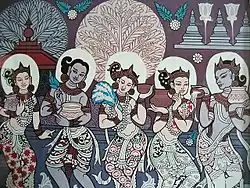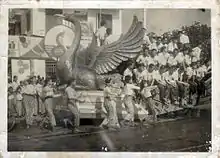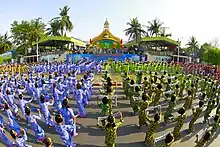| Thingyan | |
|---|---|
 Thingyan festival of Pagan Kingdom | |
| Also called | Burmese New Year |
| Observed by | The people of Burma |
| Significance | Marks the Burmese New Year |
| Observances | Water Splashing games, merit-making activities, gadaw |
| Begins | 13 April |
| Ends | 16 April |
| Date | 13–16 April |
| Frequency | annual |
| Related to | South and Southeast Asian solar New Year |
Thingyan is the Myanmar New Year festival that usually occurs in middle of April. It is a Buddhist festival celebrated over a period of four to five days, culminating in the New Year. The dates of the Thingyan Festival are calculated according to the Burmese calendar. The dates of the festival are observed as public holidays throughout Myanmar, and are part of the summer holidays at the end of the school year. Water-throwing or dousing one another from any shape or form of vessel or device that delivers water is the distinguishing feature of this festival and may be done on the first four days of the festival. The New Year takes place at virtually the same time as the new year celebrations of many countries in South Asia like China (Dai People of Yunnan Province), Laos, Thailand, Cambodia, Nepal, Bangladesh, India, and Sri Lanka.[1]



Thingyan is comparable to other festivities in the region such as the Songkran in Laos, the Songkran in Thailand, the Cambodian New Year, the Sinhalese New Year and the festivals like Vaisakhi (Punjab), Puthandu (Tamil Nadu), Vishu (Kerala) and Bihu (Assam) in India.
Names

The name "Thingyan" (Burmese: သင်္ကြန်, pronounced [θɪ́ɰ̃dʑàɰ̃]; Arakanese: [θɔ́ɰ̃kràɰ̃]) is derived from the Sanskrit word saṁkrānti, which means the "transit [of the Sun from Pisces to Aries]."[2]. The holiday is known as Sangkran (ⓘ) in Mon and as Sangkyan in Shan (Shan: သၢင်းၵျၢၼ်ႇ).
Origin & History

The story about Thingyan is a Buddhist version of Hindu mythology. The King of Brahmas called Arsi (အာသီ), lost a wager to the King of Devas, Śakra (သိကြားမင်း), who decapitated Arsi as agreed. Still, the head of an elephant was put onto the Brahma's body which then became Ganesha. The Brahma was so powerful that if the head were thrown into the sea it would dry up immediately. If it were thrown onto land it would be scorched. If it were thrown up into the air the sky would burst into flames. Sakra, therefore, ordained that the Brahma's head be carried by one goddess after another taking turns for a year each. The new year henceforth has come to signify the changing of hands of the Brahma's head.[2][3]
Although there's no evidence of when the Thingyan Festival was started, many historians said that it was established during the Tagaung Kingdom, also known as the Pyu Era, but once the Bagan Kingdom was established, Thingyan becomes one of the most famous festivals in Myanmar. The earliest stone inscription about Thingyan is found at Saw Hla Wun pagoda which dates back to 1291 AD.[1]
Thingyan Eve

The eve of Thingyan, the first day of the festival is called Pre-day (in Myanmar, အကြိုနေ့), and is the start of a variety of religious activities. Buddhists are expected to observe the Eight Precepts,[4] more than the basic Five Precepts, including having only one meal before noon. Thingyan is a time when uposatha observance days, similar to the Christian sabbath, are held. Alms and offerings are laid before monks in their monasteries and offerings of a green coconut with its stalk intact encircled by bunches of green bananas (ငှက်ပျောပွဲ အုန်းပွဲ, nga pyaw pwè oun pwè) and sprigs of thabyay (Syzygium cumini) before the Buddha images over which scented water is poured in a ceremonial washing from the head down. In ancient times, Burmese kings had a hair-washing ceremony with clear pristine water from Gaungsay Kyun (lit. Head Washing Island), a small rocky outcrop of an island in the Gulf of Martaban near Mawlamyine.[5]

Nightfall brings music, song and dance, and merrymaking in anticipation of the water festival. In neighbourhoods, pavilions with festive names constructed from bamboo, wood and beautifully decorated papier mache, are assembled overnight. Local girls rehearse for weeks and even years, in the run-up to the great event in song and dance in chorus lines. Each band of girls are uniformly dressed in colourful tops and skirts and wears garlands of flowers and tinsel. They wear fragrant thanaka - a paste of the ground bark of Murraya paniculata which acts as both sunblock and astringent - on their faces, and sweet-scented yellow padauk (Pterocarpus macrocarpus) blossoms in their hair. Padauk blooms only one day each year during Thingyan and is popularly known as the "Thingyan flower". Large crowds of revellers, on foot, on bicycles and motorbikes, and in trucks, will do the rounds of all the mandat, some making their own music and most of the women wearing thanaka and padauk. Floats, decorated and lit up, also with festive names and carrying an orchestra as well as dozens of young men on each of them, will roam the streets stopping at every mandat exchanging songs specially written for the festival including Thingyan classics, and performing than gyat (similar to rapping but one man leads and the rest bellows at the top of their voices making fun of and criticising whatever is wrong in the country today such as fashion, consumerism, runaway inflation, crime, drugs, AIDS, corruption, inept politicians etc.).[6] Accidents and incidents from drunk or reckless driving in crowded streets, as well as drunkenness, arguments and brawling are problems that typically occur. Generally, however friendliness and goodwill prevail.
Water Festival
The next day called a-kya nei (အကျနေ့) is when Thingyan fully arrives as Thagyamin makes his descent from his celestial abode to Earth. At a given signal, a cannon (Thingyan a-hmyauk) is fired and people come out with pots of water and sprigs of thabyay, then pour the water onto the ground with a prayer. A prophecy for the new year (သင်္ကြန်စာ, Thingyan sa) will have been announced by the brahmins (ponna) and this is based on what animal Thagya Min will be riding on his way down and what he might carry in his hand.[5] Children are told that if they have been good Thagya Min will take their names down in a golden book but if they have been naughty their names will go into a dog book.
Serious water throwing does not begin until a-kya nei in most of the country although there are exceptions to the rule. Traditionally, Thingyan involved the sprinkling of scented water in a silver bowl using sprigs of thabyay (Jambul), a practice that continues to be prevalent in rural areas. The sprinkling of water was intended to metaphorically "wash away" one's sins of the previous year. In major cities such as Yangon, garden hoses, huge syringes made of bamboo, brass or plastic, water pistols and other devices from which water can be squirted are used in addition to the gentler bowls and cups. Water balloons and even fire hoses have been employed. It is the hottest time of the year in the country and a good dousing is welcomed by most. All able-bodied individuals are included in this game, except for monks. Some overenthusiastic young lads may get captured by women, who often are their main target, and become kids of a practical joke with soot from cooking pots smeared on their faces. Maidens from mandat's with dozens of garden hoses exchange hundreds of gallons of water with throngs of revellers and one floats after another. Many revellers carry towels to block water from getting into their ears and for modesty as they get thoroughly soaked in their light summer clothes. The odd prankster might use ice water and a drive-by splash with this would be taken humorously. Pwè (performances) by puppeteers, orchestras, yein dance troupes, comedians, film stars and singers including modern pop groups are commonplace during this festival.
Modern-day celebrations
During the Water Festival, the Myanmar government relaxed restrictions on gatherings.[7] In the former capital, Yangon, the government permits crowds to gather on the Kandawgyi Pat Lann and Kabaraye Roads. Temporary water-spraying stations, known as pandals, are set up and double as dance floors. Many of these pavilions are sponsored by rich and powerful families and businesses [8]

The third day is known as a-kyat nei (အကြတ်နေ့) and there may be two of them, as an extra day is added in certain years. The fourth day is known as a-tet nei (အတက်နေ့) when Thagya Min returns to the heavens, the last day of the water festival. Some would throw water at people late into the day making an excuse such as "Thagya Min left his pipe and has come back for it"! Over the long festive holiday, a time-honoured tradition is mont lone yay baw (မုန့်လုံးရေပေါ်), glutinous rice balls with jaggery (palm sugar) inside thrown into boiling water in a huge wok and served as soon as they resurface which gave it the name.[2] Young men and women help in making it and all are welcome, some have put a birdseye chilli inside instead of jaggery as a trick. Mont let saung (မုန့်လက်ဆောင်း) is another Thingyan snack, made of bits of sticky rice with toasted sesame in jaggery syrup and coconut milk. They are both served with grated coconut. In major cities such as Yangon and Mandalay, Rakhine Thingyan can also be experienced as Rakhine residents of the city celebrate in their own tradition. Water is scooped from a long boat (လောင်းလှေ, laung hlei) to throw at revellers and Rakhine Mont di is served.
New Year's Day

The following is New Year's Day (နှစ်ဆန်းတစ်ရက်နေ့, hnit hsan ta yet nei). At this time Burmese visit elders and pay obeisance by gadaw (also called shihko) with a traditional offering of water in a terracotta pot and shampoo. Young people perform hairwashing for the elderly often in the traditional manner with shampoo beans (Acacia rugata) and bark. New year's resolutions are made, generally in the mending of ways and doing meritorious deeds for their karma. Releasing fish (ငါးလွှတ်ပွဲ, nga hlut pwè) is another time-honoured tradition on this day; fish are rescued from lakes and rivers that are drying up, then the fish are kept in huge glazed earthen pots and jars before being released into larger lakes and rivers with a prayer and a wish saying "I release you once, you release me ten times".[5] Thingyan (အခါတွင်း, a-hka dwin) is also a common time for shinbyu, novitiation ceremonies for boys in the tradition of Theravada Buddhism when they will join the monks (Sangha) and spend a short time in a monastery immersed in the teachings of the Buddha, the Dhamma. It is akin to rites of passage or coming of age ceremonies in other religions.
On New Year's Day, people offer food donations called satuditha (စတုဒိသာ) at various places. They typically provide free food to those participating in the New Year's celebrations. Many Burmese wash their heads with Tayaw, kinpun on Burmese New Year's Day so as to leave behind all the impurities and bad omens from the past.[9][10]
Regional traditions
- Rakhine State - The Rakhine people have three unique customs that form Thingyan, namely the nantha grinding ceremony, the nantha pouring ceremony and the water festival.[11] On the evening of New Year's Eve, Rakhine girls assemble to grind blocks of nantha sandalwood (used as a traditional cosmetic in Burma) on a kyaukpyin (a flat, circular stone used to grind sandalwood), as part of a competition.[11] The following morning, the Rakhine visit monasteries and pagodas to offer the ground nantha to Buddha statues, as a gesture of ushering the new year.[11]
- Mon State - As part of Thingyan traditions, the Mon people offer a festive dish called Thingyan rice, which consists of rice, dried snakehead fish, a generous sprinkle of fried onions, a few flakes of beeswax and served alongside a salad of unripe green mangoes.[11][12]
- Tanintharyi Region - The Bamar of Dawei and Myeik pay respects to elders and provide free meals to accompany Thaman Kyar dance performances.[11]
- Shan State - The Shan people call Thingyan "Sangkyan" (သၢင်းၵျၢၼ်ႇ) and prepare a steamed sweetmeat called khaw mun haw (ၶဝ်ႈမုၼ်းႁေႃႇ), made of glutinous rice flour and jaggery, wrapped in banana leaf.[13] This is offered to neighbors as a gift of goodwill.
- Chittagong Hill Tracts in Southeastern Bangladesh - Marma people organize water pouring stages in their villages. The main participants are young boys and girls. Apart from water pouring, they also visit a monastery to make special offerings and pray for well-being in the coming year. Marmas commonly follow the Burmese calendar.
See also
References
- Khin Myo Chit (1980). Flowers and Festivals Round the Burmese Year. Archived from the original on 2006-11-13.
Notes
- 1 2 "The Myawady Daily". 7 April 2015.
- 1 2 3 Min Kyaw Min. "Thingyan". Northern Illinois University.
- ↑ "Royal Thazin". 3 March 2020.
- ↑ "The Eight Precepts".
- 1 2 3 Shway Yoe (Sir James George Scott) 1882. The Burman - His Life and Notions. New York: Norton Library 1963. pp. 353, 348–349, 343–344.
{{cite book}}: CS1 maint: numeric names: authors list (link) - ↑ Ko Thet (June 2006). "Laughing All the Way to Prison". The Irrawaddy. Archived from the original on 2010-08-03. Retrieved 2006-07-07.
- ↑ "In Myanmar, Celebrating Water, Letting Off Steam", in the New York Times, April 20, 2009, p. A11.
- ↑ "In Myanmar, Celebrating Water, Letting Off Steam", in the New York Times, April 20, 2009, p. A11
- ↑ "နှစ်ဆန်းတစ်ရက်နေ့". Eleven Media Group (in Burmese). 17 April 2019.
- ↑ "မြန်မာရိုးရာ အတာနှစ်ကူး ခေါင်းဆေးမင်္ဂလာ". DVB (in Burmese). 14 April 2021.
- 1 2 3 4 5 Feng, Yingqiu (14 April 2010). "Ethnic style of celebrating water festival inherited in Myanmar". Xinhua. Archived from the original on 17 April 2011. Retrieved 12 April 2014.
- ↑ "A Special Thingyan Meal". Myanmar's NET. Retrieved 12 April 2014.
- ↑ Sao Tern Moeng (1995). Shan-English Dictionary. ISBN 0-931745-92-6.
External links
- Thingyan 2004 photos by Gerry Haines
- Thingyan Fun and Games
- Old Thingyan photo of a float by Goto Osami
- Thingyan Photos by Goto Osami
- Thingyan Time - When Fun-Loving Burmese Douse Their Disappointments Yeni, The Irrawaddy, April 11, 2007
- Thangyat: Traditional Songs Hard to Suppress The Irrawaddy, April 2008

